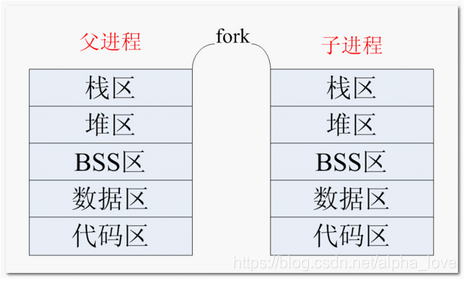需要的头文件:
#include <sys/types.h>
#include <unistd.h>
pid_t fork(void);
功能: 用于从一个已存在的进程中创建一个新进程,新进程称为子进程,原进程称为父进程。
参数:无
返回值:
成功:子进程中返回 0,父进程中返回子进程 ID。pid_t,为无符号整型。
失败:返回 -1。
失败的两个主要原因是:
1)当前的进程数已经达到了系统规定的上限,这时 errno 的值被设置为 EAGAIN。
2)系统内存不足,这时 errno 的值被设置为 ENOMEM。
测试示例如下:
#include <stdio.h>
#include <unistd.h>
#include <sys/types.h>
int main(int argc, char *argv[])
{
fork();
printf("id ==== %d\n", getpid()); // 获取进程号
return 0;
}
运行结果:

从运行结果,我们可以看出,fork() 之后的打印函数打印了两次,而且打印了两个进程号,这说明,fork() 之后确实创建了一个新的进程,新进程为子进程,原来的进程为父进程。
那子进程长什么样的呢?
使用 fork() 函数得到的子进程是父进程的一个复制品,它从父进程处继承了整个进程的地址空间:包括进程上下文(进程执行活动全过程的静态描述)、进程堆栈、打开的文件描述符、信号控制设定、进程优先级、进程组号等。子进程所独有的只有它的进程号,计时器等(只有小量信息)。因此,使用 fork() 函数的代价是很大的。

简单来说, 一个进程调用 fork() 函数后,系统先给新的进程分配资源,例如存储数据和代码的空间。然后把原来的进程的所有值都复制到新的新进程中,只有少数值与原来的进程的值不同。相当于克隆了一个自己。
实际上,更准确来说,Linux 的 fork() 使用是通过写时拷贝 (Copy- On-Write,COW技术) 实现。写时拷贝是一种可以推迟甚至避免拷贝数据的技术。内核此时并不复制整个进程的地址空间,而是让父子进程共享同一个地址空间。只用在需要写入的时候才会复制地址空间,从而使各个进行拥有各自的地址空间。也就是说,资源的复制是在需要写入的时候才会进行,在此之前,只有以只读方式共享。
子进程是父进程的一个复制品,可以简单认为父子进程的代码一样的。那大家想过没有,这样的话,父进程做了什么事情,子进程也做什么事情(如上面的例子),是不是不能实现满足我们实现多任务的要求呀,那我们是不是要想个办法区别父子进程呀,这就通过 fork() 的返回值。
fork() 函数被调用一次,但返回两次。两次返回的区别是:子进程的返回值是 0,而父进程的返回值则是新子进程的进程 ID。
测试代码:
#include <stdio.h>
#include <unistd.h>
#include <sys/types.h>
int main(int argc, char *argv[])
{
pid_t pid;
pid = fork();
if( pid < 0 ){
// 没有创建成功
perror("fork");
}
if(0 == pid){
// 子进程
while(1){
printf("I am son\n");
sleep(1);
}
}else if(pid > 0){
// 父进程
while(1){
printf("I am father\n");
sleep(1);
}
}
return 0;
}
运行结果:

通过运行结果,可以看到,父子进程各做一件事(各自打印一句话)。这里,我们只是看到只有一份代码,实际上,fork() 以后,有两个地址空间在独立运行着,有点类似于有两个独立的程序(父子进程)在运行着。需要注意的是,在子进程的地址空间里,子进程是从 fork() 这个函数后才开始执行代码。
一般来说,在 fork() 之后是父进程先执行还是子进程先执行是不确定的。这取决于内核所使用的调度算法
下面的例子,为验证父子进程各自的地址空间是独立的
#include <stdio.h>
#include <unistd.h>
#include <sys/types.h>
int a = 10; // 全局变量
int main(int argc, char *argv[])
{
int b = 20; //局部变量
pid_t pid;
pid = fork();
if( pid < 0 ){
// 没有创建成功
perror("fork");
}
if(0 == pid){
// 子进程
a = 111;
b = 222; // 子进程修改其值
printf("son: a = %d, b = %d\n", a, b);
}else if(pid > 0){
// 父进程
sleep(1); // 保证子进程先运行,但不保证1秒足够
printf("father: a = %d, b = %d\n", a, b);
}
return 0;
}
运行结果:

通过得知,在子进程修改变量 a,b 的值,并不影响到父进程 a,b 的值。
在以后的编程中,fork() 之后最好是加上判断,区别哪个是子进程的空间,哪个为父进程的空间,否则,fork() 以后的代码为父子进程各有一份,对于用户而言,没有太大意义,如例子1。
#include <stdio.h>
#include <stdlib.h>
#include <unistd.h>
#include <stdarg.h>
#include <sys/types.h>
#include <sys/wait.h>
#include <time.h>
int tprintf(const char *fmt,...);
int main(void)
{
printf("I'm your father,PID is %d.\n",getpid());
pid_t pid = fork();
if(pid == 0){
printf("I'm a first son.PID is %d.\n",getpid());
exit(1);//若此处没有exit(1), 进程也会执行 pid_t pid2 = fork()语句,会出现孙进程
printf("You should never see this.\n");
}
pid_t pid2 = fork();
if(pid2 == 0){
printf("I'm a second son.PID is %d.\n",getpid());
exit(1);
printf("You should never see this.\n");
}
pid_t pid3 = fork();
if(pid3 ==0){
printf("I'm a third son.PID is %d.\n",getpid());
exit(1);
printf("You should never see this.\n");
}
else if(pid != -1){
tprintf("Parent forked child process--%d.\n",pid);
tprintf("Parent is waiting for child to exit.\n");
waitpid(pid,NULL,0);
waitpid(pid2,NULL,0);
waitpid(pid3,NULL,0);
tprintf("Child Process had exited.\n");
tprintf("Parent had exited.\n");
}
else tprintf("Everything was done without error.\n");
return 0;
}
/*
* 设置输出格式
*/
int tprintf(const char* fmt,...)
{
va_list args;
struct tm *tstruct;
time_t tsec;
tsec = time(NULL);
tstruct = localtime(&tsec);
printf("%02d:%02d:%02d:%5d|",tstruct->tm_hour,tstruct->tm_min,tstruct->tm_sec,getpid());
va_start(args,fmt);
return vprintf(fmt,args);
}
参考资料:http://blog.csdn.net/tennysonsky/article/details/45165811